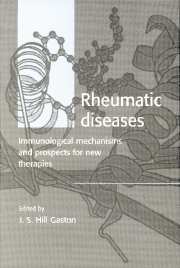Book contents
- Frontmatter
- Contents
- List of contributors
- 1 Implications of advances in immunology for understanding the pathogenesis and treatment of rheumatic disease
- 2 The role of T cells in autoimmune disease
- 3 The role of MHC antigens in autoimmunity
- 4 B cells: formation and structure of autoantibodies
- 5 The role of CD40 in immune responses
- 6 Manipulation of the T cell immune system via CD28 and CTLA-4
- 7 Lymphocyte antigen receptor signal transduction
- 8 The role of adhesion mechanisms in inflammation
- 9 The regulation of apoptosis in the rheumatic disorders
- 10 The role of monokines in arthritis
- 11 T lymphocyte subsets in relation to autoimmune disease
- 12 Complement receptors
- Index
5 - The role of CD40 in immune responses
Published online by Cambridge University Press: 06 September 2009
- Frontmatter
- Contents
- List of contributors
- 1 Implications of advances in immunology for understanding the pathogenesis and treatment of rheumatic disease
- 2 The role of T cells in autoimmune disease
- 3 The role of MHC antigens in autoimmunity
- 4 B cells: formation and structure of autoantibodies
- 5 The role of CD40 in immune responses
- 6 Manipulation of the T cell immune system via CD28 and CTLA-4
- 7 Lymphocyte antigen receptor signal transduction
- 8 The role of adhesion mechanisms in inflammation
- 9 The regulation of apoptosis in the rheumatic disorders
- 10 The role of monokines in arthritis
- 11 T lymphocyte subsets in relation to autoimmune disease
- 12 Complement receptors
- Index
Summary
Introduction
CD40 and its ligand (CD154: CD40L) play a central role in initiating and maintaining both T and B cell immune responses and are crucial in activating other effector cells such as macrophages. CD40 is far more widely expressed than previously thought, and recent data showing expression of this molecule on endothelium have implicated CD40 in the recruitment of cells at sites of inflammation. This review will focus on the experimental evidence in mouse and human that has contributed to our understanding of the normal function of this molecule in vivo. This will be viewed in the context of how CD40 contributes to disease processes, particularly autoimmune diseases, and how targeting of this model may offer new therapeutic possibilities for modifying disease activity. Although there is now some evidence for intracellular signalling pathways via CD40, these are covered elsewhere (Cheng et al., 1995; Hanissian & Geha, 1997).
Structure of CD40 family members and their ligands
CD40 is a member of an ever increasing family of receptors for which the TNF receptor is the prototype (Smith, Farrah & Goodwin, 1994). The family includes the TNF receptors, CD30, CD27, OX40, the 4-IBB antigen, Fas, nerve growth factor receptor, several viral genome products and the newly described TRAIL molecule (Pan et al., 1997). The extracellular portion of members of the TNF family share significant homology mainly because of conservation of the basic extracellular binding domain, which is composed of cysteine-rich pseudo-repeats, each containing about six cysteine motifs and 40 amino acid residues. Some molecules in the family encode soluble forms by alternative splicing. Intracellular domains, in contrast, vary considerably, indicating a likely diversity in intracellular signalling.
- Type
- Chapter
- Information
- Rheumatic DiseasesImmunological Mechanisms and Prospects for New Therapies, pp. 79 - 92Publisher: Cambridge University PressPrint publication year: 1999



